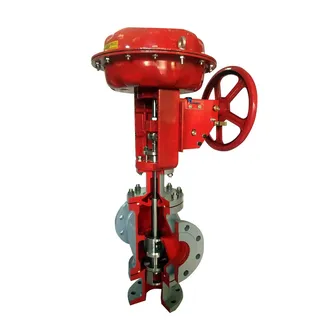Globe Control Valve
61-72 of 91 results
The three-way control valve, designed for mixing service, features specifications including 3/4-14 Inch size, Class 125-600 LB rating, ASTM A216 WCB material, and flanged, welded ends. Utilizing a multi-spring actuator, it incorporates a compact, high-output diaphragm motor with a simplified operating mechanism. Primarily employed in heat control systems such as heat converters, it also serves diverting functions. The valve's design facilitates operation in scenarios with significant port sizes and high differential pressures.
Electric control valves, crucial for industrial automation, adhere to ANSI/ISA 75.01.01 & ASME B16.34 standards. Found in oil, chemical, power generation, and pharmaceutical sectors, these valves are vital components. Our expertise ensures meticulous guidance on model parameters and operational conditions, aiding in the selection of optimal electric control valves. ASME B16.10 specifies face-to-face standards, while ASME B16.5 governs flange standards.
Introducing our Motorized Globe Control Valve, available in sizes ranging from 3/4 to 14 inches (DN20-DN350) and crafted from high-quality materials including ASTM A216 WCC, WCB, WC6, ASTM A352 LCB, ASTM A351 CF8, CF8M, CF3M, and CF3. With its motorized and electric 3-way functionality featuring a diaphragm motor, this valve offers versatility for mixing or diverting services in water, steam, or gas applications. Engineered for heavy-duty use, it ensures precise control and reliability in various industrial processes.
The Manually Operated Globe Control Valve functions as a control element but might not offer the same sealing as a standard shut-off valve. For higher sealing requirements, consider installing an additional closing valve in the pipeline. It meets relevant standards and regulations for specific parameters, suitable for non-aggressive fluids, gases, water, steam, and air. Available in sizes DN15-DN450, with pressure ratings ranging from Class 150-300 LB.
The Pneumatic Mixing Globe Control Valve operates with a plug structure designed for flow-to-open action. In mixing service control, it features two input ports and one outlet port, while in diverting service control, it has one inlet port and two outlet ports. As it functions in both opening and closing simultaneously, it doesn't rely on separate air-to-open or air-to-close mechanisms. In Direct Action Mixing Service, air failure leads to vertical flow (B → AB), whereas in Reverse Action Mixing Service, it results in horizontal flow (A → AB). Similarly, in Direct Action Diverting Service, air failure causes horizontal flow (AB → A), while in Reverse Action Diverting Service, it leads to vertical flow (AB → B).
The mixing control valve blends two fluids into a third, while the diverting control valve splits one fluid into two. In a 3-way control valve, as one flow area enlarges, the other contracts, allowing precise control. These valves can replace two 2-way control valves, suitable for liquid, gas, or steam control.
The double-seated design offers superior control in high-pressure drops and dirty fluid situations. Its dual-port setup balances pressure within, reducing actuator size and thrust needs. Dynamic force is balanced as flow opens one port and closes the other. These valves typically have higher capacity and offer flexibility in plug installation. Metal-to-metal seating ensures reliable shutoff, with options for different service conditions. Port-guided plugs are great for on-off or low-pressure throttling, while top and bottom-guided plugs ensure stable operation in severe conditions.
The Pneumatic Balanced Cage Globe Control Valves are engineered for heavy-duty applications. Featuring a compact body with an S-shaped flow passage, they ensure minimal pressure loss and regulate turbulent flow around the cage for enhanced stability. Their pressure-balanced plug design enables precise flow control even under high differential pressure, requiring minimal actuating force. Equipped with a compact diaphragm actuator loaded with multiple springs, these valves offer reliable control in high/low-temperature, high-pressure, or high-differential-pressure systems, prioritizing dynamic stability, low noise, and resistance to cavitation/flashing. They boast large flow capacity, rangeability, and high accuracy flow characteristics for versatile industrial use.
CNCV-240509-GCV-05
As a leading Bellows Seal Globe Control Valve Manufacturer, we specialize in crafting high-quality valves designed for optimal performance. Our valves feature a Single Seated design and are available in sizes ranging from 1/2 to 10 inches, suitable for Class 150-600 LB applications. Equipped with Pneumatic Diaphragm Actuators, these valves ensure reliable operation. With Flanged and Butt Welded Ends options, they offer versatility to meet diverse industrial needs.
CNCV-240509-GCV-04
As a trusted Double Seated Globe Control Valve Supplier, we offer precision-engineered valves crafted from Carbon Steel ASTM A216 WCB, ideal for demanding applications. With a size of 6 inches and DN150, these valves are designed to handle Class 150 LB and PN16 pressure ratings. They are seamlessly integrated with Pneumatic Diaphragm Multi-spring Actuators for reliable performance and precise control.
CNCV-240509-GCV-03
At our Low Noise Globe Control Valve Plant, we engineer precision valves designed to minimize noise and ensure smooth operation. These valves feature a Cage Guided, Double Seated design, suitable for applications ranging from 1-1/2 to 8 inches and accommodating Class 150-600 LB pressure ratings. Crafted from high-quality Stainless and Alloy Steel materials, they can be seamlessly integrated with pneumatic or electric actuators for optimal performance.
CNCV-240509-GCV-02
At our ASTM A351 CF3M Globe Control Valve Plant, we produce precision-engineered valves tailored to your specifications. With a DN40 size, PN16 pressure rating, and 1-1/2 inch dimensions, these valves ensure optimal performance in Class 150 LB applications. Featuring a Small Port design, Cage Guidance, and a Single-Seated configuration, they're coupled with a reliable Multi-spring Diaphragm Actuator for seamless operation.












